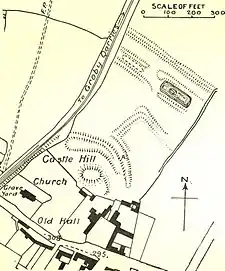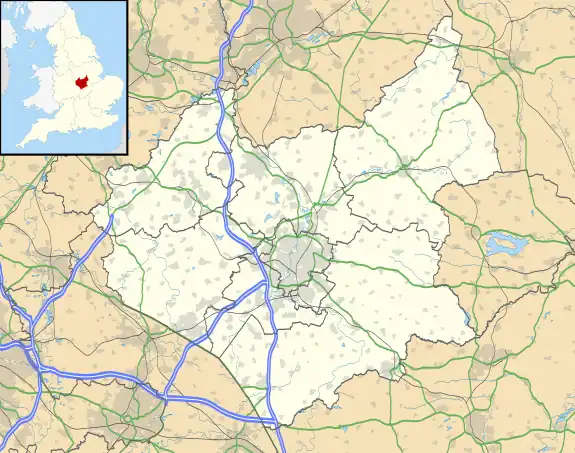Groby Castle
Groby Castle is situated in the large village of Groby to the north-west of the city of Leicester, England.
| Groby Castle | |
|---|---|
| Groby | |
 Plan of Groby Castle (prior to building of the A50 across its northern earthworks) | |
 Groby Castle Location in Leicestershire | |
| Coordinates | 52.6640°N 1.2267°W grid reference SK52390764 |
History
After the Norman Conquest, the area came into the possession of Hugh de Grandmesnil.[1] Groby was one of 67 manors Grandmesnil held in Leicestershire according to the Domesday Book of 1086.[2] The Victoria County History for Leicestershire suggests that Grandmesnil founded Groby Castle,[1] as does the English Heritage Archive.[3] However, medieval historian R. Allen Brown suggests a foundation date in the third quarter of the 12th century by the Earl of Leicester.[4] This figure was accepted by Professor Leonard Cantor[5] and David Cathcart King.[6] Excavations in the 1960s demonstrated that the motte, an artificial mound, was built around a stone tower.[7]
Along with Leicester, and Brackley, Groby was one of three castles belonging to the earl that were destroyed (slighted) on the orders of Henry II after the Revolt of 1173–1174 led by his son, Prince Henry.[8] According to historian Sidney Painter, it was one of at least 21 castles demolished on Henry II's instructions.[9]
In the 13th century a stone manor house was founded on the site.[10] Antiquarian William Burton noted in the early 17th century that Groby Castle "was utterly ruinated and gone and only the mounts, rampires and trenches were to be seen".[11]
A fragment of one wall remains, together with earthworks consisting of a large mound of earth at the rear of the present manor house known as Groby Old Hall. Part of the site is occupied by the church of St Philip and St James.[10] In 1962 and 1963 excavations were carried out at Groby Castle in preparation for the construction of the A50 road nearby.[12] The road, which runs past the north-east of the motte, destroyed some of the castle's outworks.[3] In April 2010, archaeological television programme Time Team undertook excavations at the castle.[13] Groby Castle is a Scheduled Monument,[3] which means it is a "nationally important" historic building and archaeological site which has been given protection against unauthorised change.[14]
Fictional Groby
The ancestral seat associated with the protagonist Christopher Tietjens in Ford Madox Ford's novel Parade's End (published in 1925, and dramatized for television in 2012) is named Groby Hall. The stately home, with an ancient tree growing in the grounds half the height of an even deeper well, is supposedly located in the North Riding of Yorkshire.[15]
- "Tietjens was never going to live at Groby. No more feudal atmosphere!"
- excerpted from Part VI of the third novel "A Man Could Stand Up"[16]
References
- Wall 1907, pp. 258–259
- Keats-Rohan 2004
- "Castle Hill", Pastscape, English Heritage, archived from the original on 25 March 2012, retrieved 20 March 2011
- Brown 1959, p. 268
- Cantor 1977–1978, p. 36
- King 1983, p. 253
- McWhirr & Winter 1978–1979
- Brown 1959, p. 252
- Painter 1935, p. 322
- Fry 1980
- Quoted in Cantor 1977–1978, p. 36
- Creighton 1997, p. 22
- "TV's Time Team dig deep for star find", Leicester Mercury, 17 April 2010, archived from the original on 18 April 2010, retrieved 20 March 2011
- "The Schedule of Monuments", Pastscape, English Heritage, archived from the original on 23 February 2009, retrieved 20 March 2011
- http://gutenberg.net.au/ebooks07/0700171h.html Online text of the first of four novels Some Do Not … at Project Gutenberg Australia
- http://gutenberg.net.au/ebooks07/0700191h.html Online text of A Man Could Stand Up the third of four novels at Project Gutenberg Australia
- Bibliography
- Brown, Reginald Allen (April 1959), "A List of Castles, 1154–1216", The English Historical Review, Oxford University Press, 74 (291): 249–280, doi:10.1093/ehr/lxxiv.291.249, JSTOR 558442
- Cantor, Leonard (1977–1978), "The Medieval Castles of Leicestershire" (PDF), Transactions of the Leicestershire Archaeological and Historical Society, 53: 30–41
- Creighton, Oliver (1997), "Early Leicestershire Castles: Archaeology and Landscape History" (PDF), Transactions of the Leicestershire Archaeological and Historical Society, 71 (includes a plan on page 23)
- Fry, Plantagenet Somerset (1980), The David & Charles Book of Castles, David & Charles, ISBN 0-7153-7976-3
- Keats-Rohan, K. S. B. (2004), "Grandmesnil, Hugh de (d. 1098)", Oxford Dictionary of National Biography, Oxford: Oxford University Press
- King, David James Cathcart (1983), Catellarium Anglicanum: An Index and Bibliography of the Castles in England, Wales and the Islands. Volume I: Anglesey–Montgomery, Kraus International Publications
- McWhirr, A. D.; Winter, M. J. (1978–1979), "Medieval Castles Additional Information" (PDF), Transactions of the Leicestershire Archaeological and Historical Society, 54: 74–75
- Painter, Sidney (1935), "English Castles in the Early Middle Ages: Their Number, Location, and Legal Position", Speculum, 10 (3): 321–332, doi:10.2307/2848384, ISSN 0038-7134
- Wall, Charles (1907), "Ancient Earthworks", Victoria County History of Leicestershire, vol. 1, pp. 243–276 (includes a plan on page 259)

